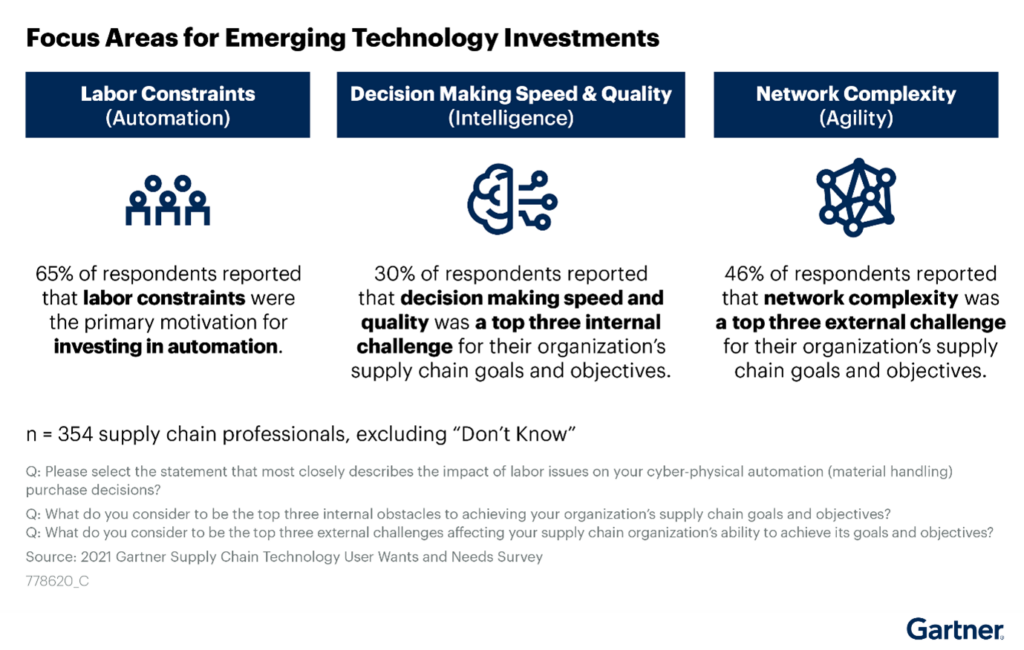Automation, Intelligence and Agility – the Future of Electronics Manufacturing explained

By Isabel Lopes, Critical Manufacturing
Electronic Manufacturing value chains are reeling under uncertain market conditions that punctuate the market today and are seeking solutions to make their operations more resilient and insulated from ever emerging risks.
Gartner published Research on Supply Chain Technology which explains what lies ahead for supply chain leaders and technology vendors. Findings from the featured surveys and subsequent analysis reveal that flexibility and resilience remain extremely important considerations for supply chain leaders. Technology, unsurprisingly, will be a key differentiator going forward, but what becomes a critical distinguishing factor where technology is concerned, is the strategic outlook required to nuance actual adoptions and implementation across the supply chain. This targeted, precise enhancement of capabilities in terms of technology has never been more critical than it is today.
We will look at the main trends and translate them into specific strategic action items for electronics manufacturing leadership.
Understanding the trends
- 99% of organizations surveyed are investing in emerging technologies, with multiple reasons cited behind making such investments.
- 4 top reasons for investments made into emerging technologies are: improved- efficiency, decision making, resilience/agility and new business endeavours.
- 90% of respondents believe technology is the source of competitive advantage and 33 % consider it critical for the success and growth of their business.
- By 2026, 50% of companies with intra-logistics robots deployed will have a multi-agent orchestration.
- By 2026, 95% of companies will have failed to establish E2E or end-to-end resiliency in their supply chains.
- By 2026, 65% of short-term decisions within supply chain planning will either be automated or autonomous.
Whilst looking at these trends, what becomes evident is that technology will play a major role in the future of each and every organization, for some it will prove to be the difference between their survival or demise, for others it will determine whether they become a market leader or perpetually lag behind their competitors.
It is also clear that companies are looking towards robotics and automation in order to make their processes more efficient and better controlled. Furthermore, resiliency is sought across the supply chain, end-to-end and drives the need to have an IT infrastructure which is integrated, intuitive and intelligent. Short term decision making is something which needs to be made autonomous or automated so that the speed of value generation and delivery improves across the supply chain.

Translating the trends into strategic action items for electronics manufacturers
Automation
For electronics manufacturers automation goes beyond the deployment of robots, co-bots and AGVs within their operation and into the way these technology pieces fit together across the production floor and the way in which they are orchestrated into delivering their expected value. The study expresses the need for organizations to be ready to adopt and adapt to multi-agent robots and automation set-up. A major deliverable here is the way in which existing IT applications incorporate new automation into the process and whether or not the execution of the process remains seamless with these new additions.
For electronics manufacturing the next frontier for automation is before and after the SMT line, which, is more automated than the process preceding it, and the packaging after. Automation and control of material moving through the plant is another key consideration. Deployment of AGVs and material handling robots is simply not enough when there is a lack of end-to-end connectivity, and their orchestration is not carried out by the same MES application driving and controlling the remaining process.
Electronics component manufacturers, EMS and CM vendors will need to look towards their MES application before deciding to automate at a rapid pace. MES is the core application driving the entire process and, unless all new robotic deployments and AGVs can be scheduled, instructed and controlled through the incumbent MES, the results from deployment will be sub-optimal.
In a complex manufacturing values chains like the ones which exist in the electronics industry, interactions between machines will not be as simple as accessing a lift or moving through a door. Thousands of interactions will take place every hour, hundreds every minute and the MES has to handle, control and choreograph all of them.
Intelligence
Gartner advocates the creation of a digital supply chain twin (DSCT) with an increased dependence on AI for better decision making in the future, and claims that most organizations would fail to achieve a DSCT connected end-to-end by 2026. Digital Twin in manufacturing is more than a buzz word nowadays, it is a reality, with the right MES application, manufacturers can have the exact replicas of their processes and assets available to them digitally. AI and advanced analytics in manufacturing are an essential deliverable for the MES platform and should lead to the proliferation of automated/autonomous decision making within the operation.
Nevertheless, what kind of MES would deliver the digital twin? What sort of decisions and capabilities would the AI/ML and advanced analytics bring for electronics manufacturing process owners?
The ideal applications to enable end-to-end connectivity and fully functional digital twins are composable, cloud-native applications, which go beyond standard APIs and integrate with all applications, equipment and allow for complete connectivity within an operation or across a given supply chain. Electronics manufacturers need to take a long and hard look at their MES and see if it has the capability to provide such seamless connectivity, first within the manufacturing process and then with enterprise applications. Digital twins would allow for better decision making, simulation would reduce R&D costs and allow for faster training and deployment of manpower or automation, as required by the process.
Despite the MES also deploying AI and advanced analytics, it uses intelligence created both in short-term/real-time decisions and long-term improvements. ML allows edge data to trigger actions allowing for alerts, actions and containment steps to be taken when an incident occurs on the shopfloor. AI then uses all incident data and creates trends which lead to long term improvements, acts as the source of innovation, and lays the foundations of automated, sustained improvement for the manufacturing process.
With uncertain supply chain responses, the MES should support electronics manufacturers to understand how they can better manage their component supply and assist in choosing alternate suppliers through correlation of quality, lead time and location. Real time monitoring of quality would allow changes to be made in supply chain configuration based on consumption and rejection data. Furthermore, AI would suggest changes to product design based on component availability and support R&D to make better commercial decisions at the prototyping stage. Within the process every small improvement, such as decreased waiting time for components, faster replenishment of and readying of production lines all depends on better process analytics and control, which the MES should ideally provide.
Resilience comes from the ability to be un-phased in times of adversity and this is the direct result of intelligence.
Can your MES deliver this intelligence?
Agility
Network complexity is seen as a major challenge by most organizations and this complexity invariably leads to a lack of agility. Future applications need to be composable in nature. Many vendors are augmenting their current monolithic applications with micro-services to allow for some degree of flexibility in deployment and change requests. However, partial flexibility should not be considered a substitute for fully cloud-native, containerization enabled applications which allow each and every functional package to exist as an individual entity with clearly defined integration protocols in place.
For electronics manufacturers being agile would mean having to let go of their rigid legacy applications and custom built point applications and might turn out to be a bigger challenge than choosing the right MES and deploying it across the value chain. Switching to a new application, while being extremely logical and in the coming years essential for survival, requires a lot to be done from a change management perspective and getting users on board for the change.
SMT lines are rife with point solutions and legacy applications, with no connectivity with packaging and material movement. This is a serious concern. They need to look for a single MES application that connects the whole process, orchestrates material, machines, and manpower. The application must be user-friendly and composable, allowing end-to-end visibility of the whole process, not just the SMT line.
For electronics manufacturers, looking for a fully connected supply chain is essential for a better future, having a fully connected manufacturing operation is mission critical, today. As the trends dictate, manufacturers must look at areas to automate, but use automation not only in production process, but through the MES, use it to better execute decision making and fact-based actions. Furthermore, choose the right application and vendor to create a digital twin to help reach future DSCT goals.
Isabel Lopes is a Business Developer Specialist for Critical Manufacturing. With an extensive background in international business development, she’s the go-to-person for the Electronics & SMT industries. When she’s not busy learning, researching and identifying new business opportunities, you most probably will find her in an airplane on her way to unknown and remote destinations.













